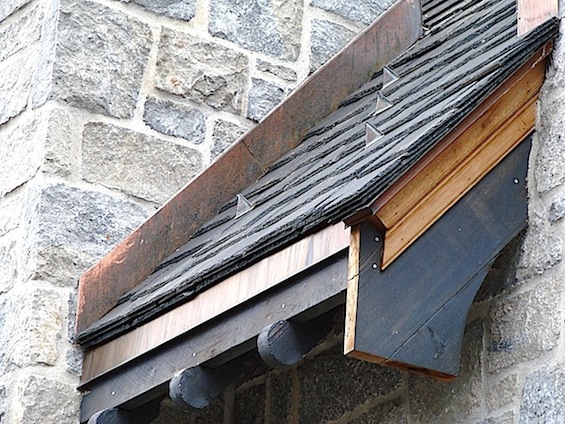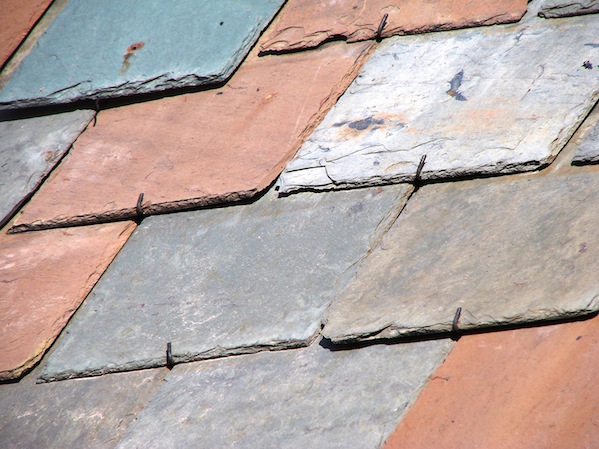Mastering Roof Inspections: Slate Roofs, Part 6
by Kenton Shepard and Nick Gromicko, CMI®
The purpose of the series “Mastering Roof Inspections” is to teach home inspectors, as well as insurance and roofing professionals, how to recognize proper and improper conditions while inspecting steep-slope, residential roofs. This series covers roof framing, roofing materials, the attic, and the conditions that affect the roofing materials and components, including wind and hail.
Starter Course


As with other overlapping roofing materials, the first course of slate -- the starter course -- should be doubled. In the starter course, the underlying slates are installed chamfer down and should rest on a cant strip installed at the roof edge. All other field slates are installed with the chamfer facing up. The chamfer is created when the slate is cut.
The main purpose of the cant strip is to elevate the starter course onto the same plane as the slates on the rest of the roof. If the roof lacks a chamfer strip, check for cracked slates in the starter course. The secondary purpose is to prevent water from pooling behind a section of raised fascia or wood strip.
Slates should overhang the roof edges by 1½ to 2 inches. The overhang should be adequate to protect the framing from runoff, but not so much that it causes runoff to overshoot the gutter.
Field Slates
Slates that cover the main part of the roof are called field slates. Other types of slates include hip and ridge cap slates, and valley slates, which are cut to meet at the valleys.
Fastening


Nailed slate
You should check a representative number of slates for the fastening method. When it comes to nailing practices, slate installation is different from other roofing materials. In North America, nailing is the most common fastening method, although you may see hooks used, especially for repairs.


Sometimes, entire roofs are installed with hooks. Slate has also been hung from wires.

During the manufacturing process, nail holes are punched from the back of each tile. This method causes a small blow-out in the face of each tile which provides a countersink for the nails holding the tile in place.

Nail holes are usually punched 1¼ to 2 inches in from each edge and about a quarter of the length of the tile down from the top. Holes punched too low or too far from the edges of the tiles may cause leaks. Most slates have two holes. Slates thicker than 1 inch should have two additional holes located 2 inches above the two original holes.
Nails are driven so that the slates hang from the nail shanks instead of being held in place by pressure from the nail heads. Nails driven too tightly can crack slate tiles as the substrate expands from moisture absorption.
Nails that are incompletely driven may damage the overlying tile and increase the chance that wind-driven rain will penetrate the roof. Acceptable nails are copper, stainless steel, and hot-dipped galvanized. Stainless steel nails are the most desirable. Hot-dipped galvanized steel nails are the least desirable. Electroplated galvanized nails are a defective installation.
If the fasteners in general are at the end of their useful lives, it may be possible to remove and re-install slates, depending on the condition of the tiles. The closer the slates are to the end of their useful lives, the less sense it makes to remove and re-install them.
If you see evidence of leakage in slate roof tiles but don’t see missing or damaged tiles, check the nail hole locations and nailing methods. The photo below shows headwall flashing that has been nailed and the nail head has been left unsealed.

Courtesy of Joseph Jenkins, Inc.

A better way to install headwall flashing, shown above, is to use cleats. The cleat is installed before the flashing and then bent around the flashing to hold it in place.
If you see slates broken in line with the fasteners, they may not have countersinks or may have been nailed too tightly.

Courtesy of Joseph Jenkins, Inc.
Nails left protruding can wear right through the overlying slate, as you can see in the photo above. This condition has caused the slate to delaminate. In the photo below, this condition has caused the slate to split, opening an avenue for roof leakage.

Courtesy of Joseph Jenkins, Inc.
Fasteners may fail before the slate does. If you see many repairs or displaced tiles, check the condition of the nails over a few representative portions of the roof, especially on homes approaching 70 years of age. If many fasteners are failing, it can be a real problem. The slates may be salvageable, but if they’re less than ¼-inch thick, they probably won't be.
**************************************************
Learn how to master a roof inspection from beginning to end by reading the entire InterNACHI series: Mastering Roof Inspections.
Take InterNACHI’s free, online Roofing Inspection Course
Mastering Roof Inspections
Roofing Underlayment Types
Inspecting Underlayment on Roofs
Fall-Arrest Systems
Roofing (consumer-targeted)
More inspection articles like this

